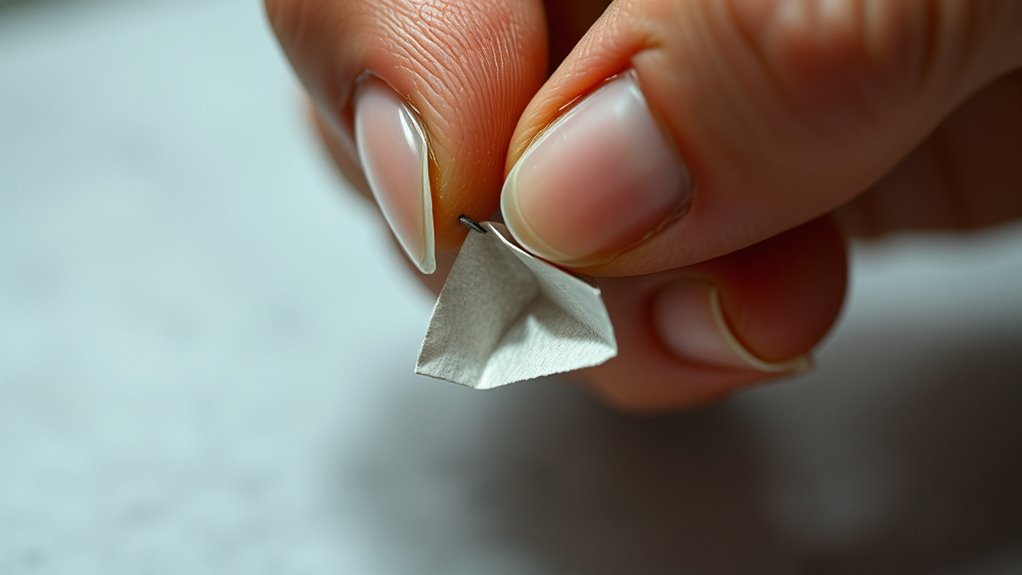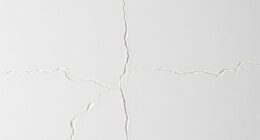When repairing corner beads, metal options are more durable and can be straightened or patched if slightly damaged, making them ideal for long-term use. Paper beads are easier to install and replace but tend to need complete replacement if chipped or bent. Reinforcing joints and finishing properly are key for both types to last. To learn how to choose and repair each type effectively, keep exploring the essential techniques for durable, professional corners.
Key Takeaways
- Metal corner beads are durable and can be repaired by straightening or replacing damaged sections, while paper beads typically require full replacement.
- Minor damage to metal beads can be reinforced with drywall mud, but paper beads usually need complete removal and replacement.
- Installing metal beads provides a rigid edge that can be seamlessly finished with multiple coats of joint compound and sanding, unlike paper beads.
- Proper reinforcement and finishing techniques are essential for both types to ensure a durable, professional-looking corner.
- Repairing metal beads often involves straightening or replacing, whereas paper beads are more vulnerable and generally require complete removal when damaged.

Have your corner beads become damaged or chipped over time? If so, it’s vital to understand your options for repair, especially when deciding between metal and paper corner beads. Both types serve the same purpose—protecting corners and providing a clean, finished look—but they differ markedly in installation, durability, and repair techniques. When working with either, paying attention to joint reinforcement and finishing techniques will help you achieve a seamless repair that lasts. Metal corner beads are renowned for their strength and durability. They’re typically made of galvanized steel or aluminum, which makes them resistant to dents and impacts. If your metal bead gets bent or chipped, you can usually straighten or replace it with relative ease. Repairing a damaged metal corner bead often involves removing the compromised section and installing a new one, but if the damage is minor, you might be able to reinforce the joint with additional drywall mud or joint compound around the edges. This reinforcement helps prevent future cracking or chipping at the repair site. When finishing, apply multiple coats of joint compound, feathering each layer out to blend smoothly into the wall surface. Sand lightly between coats to guarantee a flush, professional look. Metal beads are also excellent for finishing techniques because they provide a rigid edge that supports a smooth, sharp corner once properly finished. Enhanced data processing speeds in recent AI advancements help streamline the application of joint compound and finishing techniques, ensuring a more efficient and precise repair process. Paper corner beads, on the other hand, are made of heavy-duty paperboard coated with a plastic or paper film, making them lightweight and easy to install. They’re particularly popular for DIY projects because they’re inexpensive and simple to cut and shape. When paper beads become damaged or chipped, repair isn’t as straightforward. Instead, you typically need to replace the entire bead, as patching paper isn’t usually effective. For joint reinforcement, you want to guarantee the drywall around the corner is well secured and smooth before installing a new paper bead. Use drywall tape and joint compound to reinforce the joints and create a strong bond between the wall surfaces and the bead. Finishing techniques with paper beads involve applying a generous layer of joint compound over the bead and feathering it out onto the wall. Sand carefully once dry to achieve a seamless transition from wall to corner. Proper finishing techniques are vital to hide the bead completely and ensure the corner appears crisp and professional.
Frequently Asked Questions
How Do I Choose Between Metal and Paper Corner Beads?
You should choose between metal and paper corner beads based on durability and cost considerations. Metal beads are more durable and resist dents, making them ideal for high-traffic areas. Paper beads are cheaper and easier to install, perfect for quick projects or budgets. If you need long-lasting results, go for metal. For affordability and easier handling, paper is a smart choice. Consider your project’s needs before making a decision.
What Tools Are Essential for Repairing Corner Beads?
To repair corner beads effectively, you need essential tools like a utility knife, metal snips (for metal beads), and a putty knife. Your choice of material comparison influences your installation techniques—metal beads require snips and more precise alignment, while paper beads need careful taping and mudding. These tools make certain a neat finish, whether you’re working with durable metal or flexible paper, making your repair smoother and more professional.
Can Corner Bead Repairs Be Done Without Professional Help?
Yes, you can repair corner beads yourself, but be aware of DIY challenges like mastering proper finishing techniques and ensuring a smooth, durable edge. While it’s cost-effective, you might face difficulties if you’re unfamiliar with drywall repair. Take your time, gather the right tools, and follow tutorials carefully. If unsure, consulting a professional can save you from costly mistakes and achieve a better finish.
How Long Does a Typical Corner Bead Repair Last?
A typical corner bead repair lasts about 10 to 15 years, like a sturdy brick wall standing strong. Metal corner beads often offer better durability, making them last longer, while paper ones might need more frequent touch-ups. Your choice affects durability comparison and aesthetic considerations—metal provides a sleek, lasting finish, whereas paper may require redoing sooner but can be easier to work with initially. Proper sealing and finishing extend your repair’s lifespan profoundly.
Are There Specific Wall Types Better Suited for Metal or Paper Beads?
You should choose metal corner beads for smooth wall textures and areas prone to moisture, like bathrooms, because they’re more moisture-resistant and durable. Paper beads work well on textured walls and in low-moisture spaces, offering easier installation. Consider your wall’s texture and exposure to humidity when selecting, as these factors influence the longevity and performance of the corner bead.
Conclusion
In the battle of metal versus paper corner beads, your choice can make or break your entire wall! Imagine a tiny mistake turning into a disaster of epic proportions, ruining your masterpiece in seconds. Don’t let flimsy paper or stubborn metal turn your project into a nightmare. Pick the right repair method now, and save yourself from a disaster so huge, it’ll make your head spin. Trust me, your walls deserve the best—so don’t settle for anything less!









